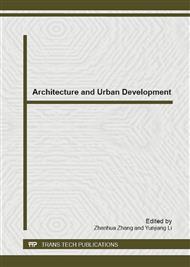[1]
Bi Jun.Construction Path of the Low Carbon City on the Post-crisis Era [J].Nanjing Social Sciences ,2009(11):12-16.
Google Scholar
[2]
World Bank ,World Development Report 2009 :Reshaping Economic Geography[M],Hu GuangYu translation.Beijing:Tsinghua University Press,2009:191.
Google Scholar
[3]
QuayP D, Tilbrook B, WongCS. Oceanic uptake of f ossil fuel CO2: carbon213evidence[ J]. Science, 1992,256: 74279.
Google Scholar
[4]
HoughtonRA, Hackler J L. Sources andsinks of car2 bonfromland2use change in China[ J] .Global Biogeo2 chemical Cycles,2003, 17:1034-1047.
Google Scholar
[5]
Houghton RA. The annual net fluxof carbontothe atmosphere fromchanges in land use 1850-1990[ J].Tellus Series B2 Chemical and Physical Meteorology,1999,51: 298-313.
DOI: 10.3402/tellusb.v51i2.16288
Google Scholar
[6]
Liu Ying, Zhao Rong-qin.The Advances and Trends of Land Use and Land Cover Change Research[J],Journal of Hebei Normal Uniersity(Natural Science Edition)2004,28(3)
Google Scholar
[7]
Shochat E, Warren PS, Faeth SH (2006). From patterns to emerging processes in mechanistic urban ecology. Trends in Ecology and Evolution, 21(4), 186–191
DOI: 10.1016/j.tree.2005.11.019
Google Scholar
[8]
Hong-yu Zhao, Guo Xiang-ming, Chu Jun. Low-Carbon Urban Planning from the Perspective of "Carbon Footprint" .J. Planners.2010(5):9-15
Google Scholar
[9]
Pan Hai-xiao: Urban spatial structure towards Low Carbon New Urban Transport and Land Use Model[J],Urban Studies.40-45(2010)
Google Scholar
[10]
Chen Cong-xi, Huang Xian-jin, Lin Bo-qiang. Good use, and manage resources,Practice of low carbon development[ N] .China's land resource news,2010-4-23
Google Scholar
[11]
Cai Yang-wei, Zhang Yang. Rethinking Danwei Community in Urban China: Actions to Global Climate Changes[J],International Urban Planning, 2010(1):20-23.
Google Scholar
[12]
Hildebrand F. Designing the City:Towards a More Sustainable Urban Form(M).London and New York:E&FN Span,1999.
Google Scholar
[13]
Liu Zhi-lin, Zhang Yan, Cai Yan-wei. Home-Work Separation in the Context of Institutional and Spatial Transformation in Urban Chian: Evidence from Beijing Household Survey Data,Urban Studies,2009,16(9):110-117
Google Scholar
[14]
Li Qiang, Li Xiao-lin. The Characteristics of Resident's Working-trip in Inner-suburb of Beijing[J].Urban Problems,2007(7):55-59.
Google Scholar
[15]
Yang Jiawen. Transportation Implications of Land Development in a Transitional Economy: evidence from housing relocation in Beijing[J].Transportation Research Record,2006,7-14.
DOI: 10.1177/0361198106195400102
Google Scholar


